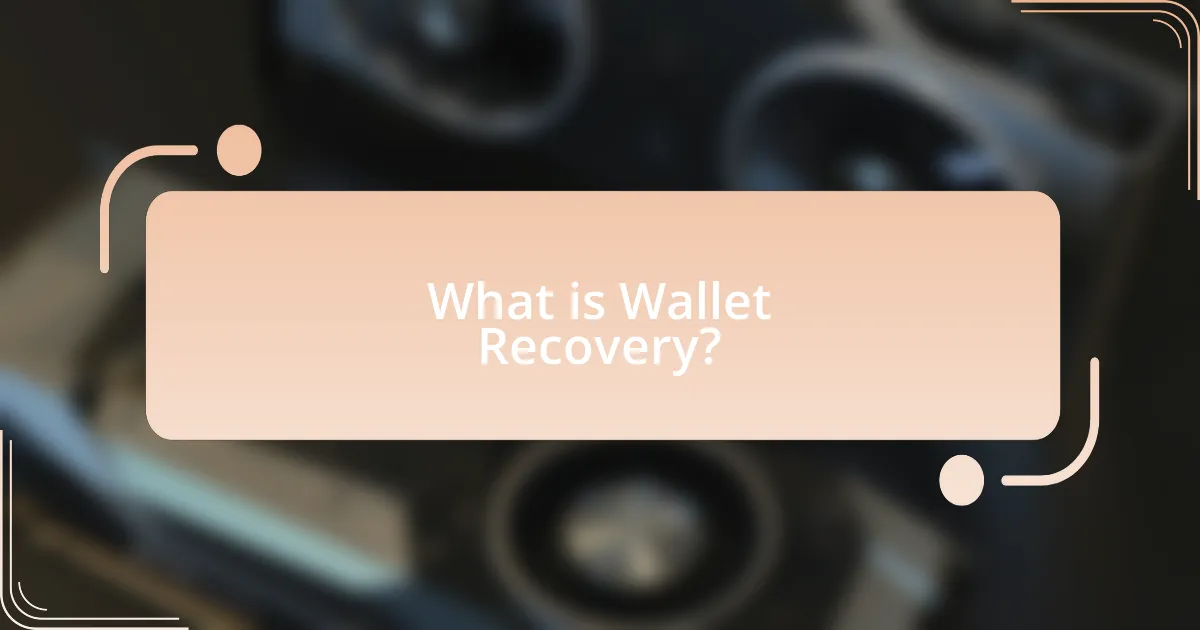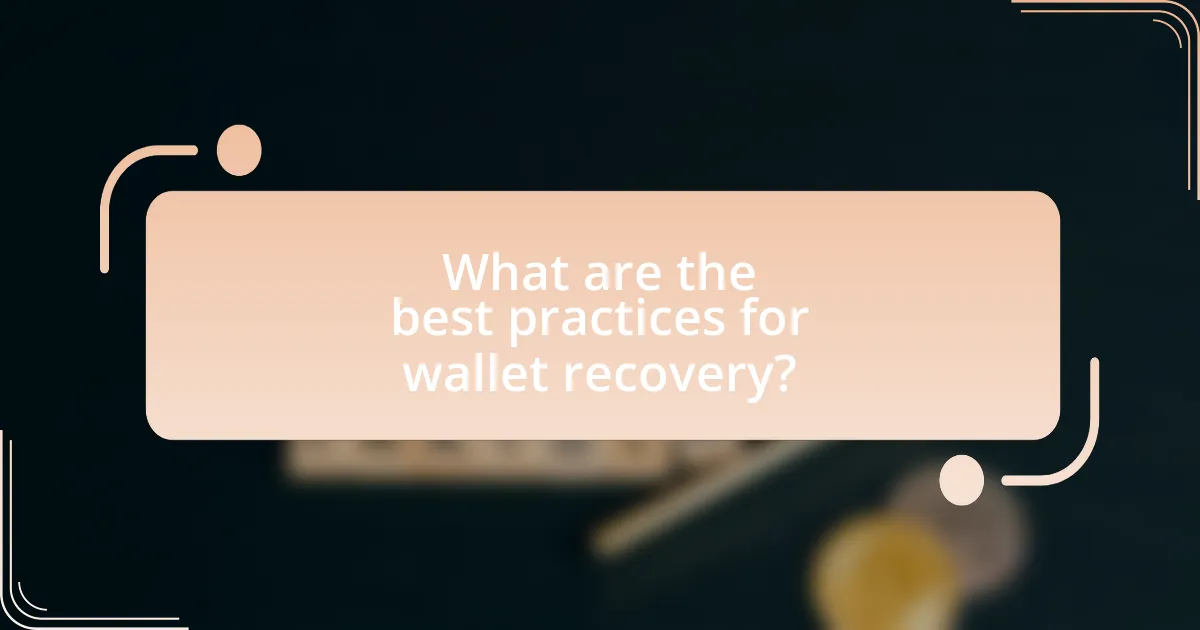Wallet recovery is the process of regaining access to a digital wallet after losing credentials, such as passwords or private keys. This article outlines the importance of wallet recovery, the risks associated with losing access, and the types of wallets that require recovery methods. It details steps to take immediately after losing access, assesses the situation, and discusses various recovery methods, including the use of recovery phrases and backup files. Additionally, best practices for securing wallets and preventing future access loss are highlighted, emphasizing the significance of proper storage and security measures to safeguard digital assets.

What is Wallet Recovery?
Wallet recovery refers to the process of regaining access to a digital wallet after losing the ability to access it, typically due to forgotten passwords, lost private keys, or device failures. This process often involves using recovery phrases or backup keys that were generated during the wallet setup, which serve as a means to restore access to the wallet’s contents. For instance, many cryptocurrency wallets provide a 12 to 24-word recovery phrase that can be used to recover the wallet on a new device or application, ensuring that users can retrieve their funds even if they lose their original access method.
Why is Wallet Recovery important?
Wallet recovery is important because it enables users to regain access to their digital assets after losing their wallet credentials. This process is crucial as it protects users from permanent loss of funds, which can occur due to forgotten passwords, lost devices, or other access issues. According to a report by Chainalysis, approximately 20% of Bitcoin is considered lost, highlighting the significance of effective wallet recovery methods to prevent financial loss.
What risks are associated with losing access to a wallet?
Losing access to a wallet poses significant risks, primarily the permanent loss of funds stored within that wallet. When access is lost, users cannot retrieve their private keys or recovery phrases, which are essential for regaining control over their assets. This situation can lead to financial loss, as cryptocurrencies and digital assets are often irretrievable without these credentials. According to a study by Chainalysis, approximately 20% of all Bitcoin is considered lost due to inaccessible wallets, highlighting the severity of this risk.
How can losing access impact your digital assets?
Losing access to your digital assets can result in permanent loss of ownership and control over those assets. Digital assets, such as cryptocurrencies or online accounts, are often secured by private keys or passwords; without access to these, users cannot retrieve or manage their assets. According to a study by Chainalysis, approximately 20% of all Bitcoin is considered lost due to lost access, highlighting the significant impact of this issue.
What types of wallets require recovery?
Hot wallets and hardware wallets require recovery. Hot wallets, which are connected to the internet, often store private keys online and can be vulnerable to hacks, necessitating recovery options. Hardware wallets, while more secure, also require recovery methods, typically through seed phrases, to restore access if the device is lost or damaged. Both types emphasize the importance of securely storing recovery information to regain access to funds.
What are the differences between hot wallets and cold wallets?
Hot wallets are online wallets that are connected to the internet, allowing for quick access and transactions, while cold wallets are offline storage solutions that provide enhanced security by keeping private keys disconnected from the internet. The primary difference lies in their connectivity; hot wallets facilitate immediate access and ease of use, making them suitable for frequent transactions, whereas cold wallets prioritize security, making them ideal for long-term storage of cryptocurrencies. For instance, a study by the Cambridge Centre for Alternative Finance indicates that cold wallets are less susceptible to hacking, as they are not exposed to online threats, thus reinforcing their security advantage over hot wallets.
How do hardware wallets handle recovery differently?
Hardware wallets handle recovery differently by utilizing a seed phrase, which is a series of words generated during the wallet setup, to restore access to funds. Unlike software wallets that may rely on cloud backups or account recovery options, hardware wallets store the seed phrase securely offline, ensuring that only the user has access to it. This method enhances security, as the seed phrase can be used to regenerate private keys and recover the wallet on a new device if the original is lost or damaged. The reliance on a seed phrase is a standard practice in hardware wallets, as it minimizes the risk of unauthorized access and data breaches associated with online recovery methods.

What steps should you take immediately after losing access?
Immediately after losing access to a wallet, the first step is to secure your recovery phrase or private keys, if available. This phrase or keys are essential for regaining access to your funds. Next, attempt to recover access through any available recovery options provided by the wallet service, such as password recovery or two-factor authentication methods. If these methods fail, contact the wallet provider’s customer support for assistance, as they may have specific protocols for recovery. Additionally, ensure that you monitor your wallet for any unauthorized transactions, as prompt action can help mitigate potential losses.
How can you assess the situation?
To assess the situation of losing access to a wallet, first identify the type of wallet involved, whether it is a hardware, software, or paper wallet. Next, evaluate the circumstances surrounding the loss, such as whether the wallet was misplaced, stolen, or if access was lost due to forgotten credentials. Gathering information about recent transactions can also provide insights into the wallet’s status. For instance, if the wallet is a software wallet, checking for any backup options or recovery phrases is crucial. According to a study by the Blockchain Research Institute, 20% of cryptocurrency holders have lost access to their wallets, emphasizing the importance of understanding the specific recovery options available for each wallet type.
What initial actions should you take to secure your assets?
To secure your assets, immediately change passwords for all accounts associated with your assets and enable two-factor authentication. This action protects against unauthorized access, as studies show that accounts with two-factor authentication are 99.9% less likely to be compromised. Additionally, back up your wallet recovery phrases in a secure location, as losing access to these phrases can result in permanent loss of assets. Implementing these initial steps significantly reduces the risk of asset theft or loss.
How can you determine if recovery is possible?
To determine if recovery is possible, assess the availability of backup information such as seed phrases, private keys, or recovery phrases associated with the wallet. If these recovery options are accessible, the likelihood of successful recovery increases significantly. For instance, a study by the Blockchain Research Institute indicates that users who maintain secure backups have a 90% success rate in wallet recovery.
What recovery methods are available?
Recovery methods available for wallet access include seed phrase recovery, password recovery, and recovery through customer support. Seed phrase recovery involves using the original seed phrase provided during wallet setup to restore access. Password recovery typically requires answering security questions or using email verification to reset the password. Recovery through customer support involves contacting the wallet provider for assistance, which may include identity verification processes. These methods are widely recognized in the cryptocurrency community as effective ways to regain access to lost wallets.
How do recovery phrases work?
Recovery phrases work by providing a secure method to restore access to a cryptocurrency wallet. These phrases, typically consisting of 12 to 24 words, are generated during the wallet setup and serve as a backup. When a user loses access to their wallet, entering the recovery phrase into a compatible wallet application allows them to regain control over their funds. This process relies on the cryptographic principles of deterministic wallets, where the same recovery phrase will always generate the same wallet addresses and private keys, ensuring that users can recover their assets as long as they have the correct phrase.
What role do backup files play in wallet recovery?
Backup files are essential for wallet recovery as they store critical information needed to restore access to a digital wallet. These files typically contain private keys, recovery phrases, or other authentication data that enable users to regain control over their assets after losing access due to device failure, loss, or theft. The importance of backup files is underscored by the fact that without them, users may permanently lose their funds, as many wallets do not have alternative recovery methods.

What are the best practices for wallet recovery?
The best practices for wallet recovery include securely backing up recovery phrases, using hardware wallets, and enabling two-factor authentication. Securely backing up recovery phrases ensures that users can restore access to their wallets if they lose their devices; for example, storing the phrase in a safe location, such as a safe deposit box, minimizes the risk of loss. Utilizing hardware wallets provides an additional layer of security, as these devices store private keys offline, making them less vulnerable to hacking. Enabling two-factor authentication adds another security measure, requiring a second form of verification to access the wallet, which significantly reduces the risk of unauthorized access. These practices are essential for maintaining wallet security and ensuring recovery options are available when needed.
How can you prevent future access loss?
To prevent future access loss, regularly back up your wallet’s recovery phrases and private keys in secure locations. This practice ensures that you can restore access to your wallet even if your device is lost or damaged. According to a study by the Blockchain Research Institute, 30% of cryptocurrency users have lost access to their wallets due to inadequate backup practices, highlighting the importance of secure storage methods such as encrypted USB drives or physical safes.
What security measures should you implement?
To ensure the security of your wallet, implement multi-factor authentication (MFA), strong password policies, and regular software updates. Multi-factor authentication adds an extra layer of protection by requiring additional verification methods beyond just a password, significantly reducing the risk of unauthorized access. Strong password policies, which include using complex passwords and changing them regularly, help prevent brute-force attacks. Regular software updates are crucial as they patch vulnerabilities that could be exploited by attackers, thereby enhancing overall security. According to a study by the Cybersecurity & Infrastructure Security Agency, organizations that implement MFA can reduce the risk of account compromise by 99.9%.
How can regular backups enhance wallet security?
Regular backups enhance wallet security by ensuring that users can restore their wallet data in case of loss, theft, or corruption. By maintaining up-to-date copies of wallet information, users mitigate the risk of permanent loss of access to their funds. For instance, if a device is compromised or a wallet application fails, having a backup allows for quick recovery without losing assets. Studies indicate that 20% of cryptocurrency users have lost access to their wallets due to device failure or accidental deletion, underscoring the importance of regular backups in safeguarding digital assets.
What common mistakes should you avoid during recovery?
During recovery, you should avoid common mistakes such as not backing up recovery phrases, sharing sensitive information, and neglecting security measures. Failing to back up recovery phrases can lead to permanent loss of access to your wallet, as these phrases are essential for regaining control. Sharing sensitive information, like private keys or passwords, increases the risk of theft and unauthorized access. Additionally, neglecting security measures, such as enabling two-factor authentication, can leave your wallet vulnerable to attacks. These mistakes can significantly hinder the recovery process and result in irreversible loss of assets.
Why is it important to avoid sharing recovery information?
It is important to avoid sharing recovery information because doing so can lead to unauthorized access to sensitive accounts and assets. When recovery information, such as passwords or recovery phrases, is disclosed, it increases the risk of identity theft and financial loss. For instance, a study by the Federal Trade Commission reported that in 2020, over 1.4 million identity theft reports were filed, many stemming from shared or compromised recovery information. Therefore, safeguarding recovery information is crucial to maintaining the security and integrity of personal and financial data.
What are the risks of using unverified recovery tools?
Using unverified recovery tools poses significant risks, including data loss, malware infection, and unauthorized access to sensitive information. These tools may not have undergone rigorous testing, leading to potential failures in recovering lost data. Additionally, unverified tools can contain malicious code that compromises the security of the device, resulting in data theft or system damage. A study by the Cybersecurity and Infrastructure Security Agency highlights that 60% of unverified software can harbor vulnerabilities that attackers exploit, underscoring the importance of using trusted recovery solutions.
What are some practical tips for successful wallet recovery?
To successfully recover a wallet, users should first ensure they have access to their recovery phrase or seed phrase, which is crucial for restoring access. This phrase typically consists of 12 to 24 words and is generated during the wallet setup. Users must store this phrase securely, preferably offline, to prevent unauthorized access. Additionally, regularly updating wallet software and enabling two-factor authentication can enhance security and facilitate recovery. According to a study by the Blockchain Research Institute, 70% of users who lost access to their wallets did not have their recovery phrases saved securely, highlighting the importance of proper storage practices.